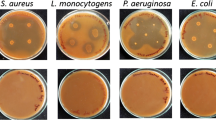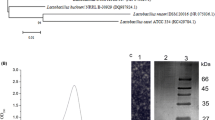Abstract
Actinobacteria are important organisms used mainly for the production of enzymes of commercial importance and secondary metabolites in many industries. The secondary metabolites from Actinobacteria have functions in physiology, communications, medicine etc. Bacteriocin is one such secondary metabolite produced by Actinobacteria, which functions as antimicrobials. Bacteriocins are synthesized in the ribosomes which are proteins or peptides having potential as antimicrobials with low potential to development of resistance. Bacteriocins are generally classified into two major groups based on the presence or absence of lanthionine. Bacteriocins have potential as a bioprotectant and are mostly used in the food preservation sector. The usual process of production of bacteriocin involves selection and isolation of strains from a population. The selected strains are then cultured and identified by their 16S rRNA sequence. One of the standard methods for molecular mass determination is SDS-PAGE analysis. The SDS-PAGE uses a denaturing condition with an anionic detergent sodium-dodecyl sulfate. Polyacrylamide gel is used in the determination of apparent molecular mass based on the separation of proteins on the gel. In this chapter we present a method to determine the molecular mass of bacteriocin by SDS-PAGE.
Access this chapter
Tax calculation will be finalised at checkout
Purchases are for personal use only
Similar content being viewed by others

References
Barka EA, Vatsa P, Sanchez L, Gaveau-Vaillant N, Jacquard C, Klenk H-P, Clément C, Ouhdouch Y, van Wezel GP (2015) Taxonomy, physiology, and natural products of Actinobacteria. Microbiol Mol Biol Rev 80(1):1–43. https://doi.org/10.1128/mmbr.00019-15
Embley TM, Stackebrandt E (1994) The molecular phylogeny and systematics of the Actinomycetes. Annu Rev Microbiol 48(1):257–289. https://doi.org/10.1146/annurev.mi.48.100194.001353
Gao B, Gupta RS (2012) Phylogenetic framework and molecular signatures for the main clades of the phylum actinobacteria. Microbiol Mol Biol Rev 76(1):66–112. https://doi.org/10.1128/mmbr.05011-11
Bérdy J (2005) Bioactive microbial metabolites. J Antibiot 58(1):1–26. https://doi.org/10.1038/ja.2005.1
vanBelkum MJ, Martin-Visscher LA, Vederas JC (2011) Structure and genetics of circular bacteriocins. Trends Microbiol 19(8):411–418. https://doi.org/10.1016/j.tim.2011.04.004
Bierbaum G, Sahl H-G (2009) Lantibiotics: mode of action, biosynthesis and bioengineering. Curr Pharm Biotechnol 10(1):2–18. https://doi.org/10.2174/138920109787048616
Riley MA, Chavan MA (2006) Bacteriocins: ecology and evolution, 2007th edn. Springer, Berlin
Nissen-Meyer J, Rogne P, Oppegard C, Haugen H, Kristiansen P (2009) Structure-function relationships of the non-lanthionine-containing peptide (class II) bacteriocins produced by gram-positive bacteria. Curr Pharm Biotechnol 10(1):19–37. https://doi.org/10.2174/138920109787048661
Meade S, Garvey (2020) Bacteriocins, potent antimicrobial peptides and the fight against multi drug resistant species: resistance is futile? Antibiotics 9(1):32. https://doi.org/10.3390/antibiotics9010032
Cotter P, Hill C, Ross R (2005) Bacterial Lantibiotics: strategies to improve therapeutic potential. Curr Protein Pept Sci 6(1):61–75. https://doi.org/10.2174/1389203053027584
Bhat UG, Halasi M, Gartel AL (2009) Thiazole antibiotics target FoxM1 and induce apoptosis in human cancer cells. PLoS One 4(5):e5592. https://doi.org/10.1371/journal.pone.0005592
Fredenhagen A, Fendrich G, Märki F, Märki WA, Gruner J, Raschdorf F, Peter H, H. (1990) Duramycins B and C, two new lanthionine containing antibiotics as inhibitors of phospholipase A2. Structural revision of duramycin and cinnamycin. J Antibiot 43(11):1403–1412. https://doi.org/10.7164/antibiotics.43.1403
Ernst O, Zor T (2010) Linearization of the Bradford protein assay. J Vis Exp (38):1918. https://doi.org/10.3791/1918
Mulyawati AI, Ardyati T, Jatmiko YD (2019) Partial purification and characterization of bacteriocins from Lactobacillus plantarum SB7 and Bacillus amyloliquefaciens BC9 isolated from fermented Sumbawa mare’s milk as food preservative candidates. In: International conference on biology and applied science. https://doi.org/10.1063/1.5115747
Author information
Authors and Affiliations
Editor information
Editors and Affiliations
Rights and permissions
Copyright information
© 2022 The Author(s), under exclusive license to Springer Science+Business Media, LLC, part of Springer Nature
About this protocol
Cite this protocol
Arul, S., Jayashankar, M., Dayalan, H. (2022). Molecular Mass Determination of Bacteriocin by SDS-PAGE Analysis. In: Dharumadurai, D. (eds) Methods in Actinobacteriology. Springer Protocols Handbooks. Humana, New York, NY. https://doi.org/10.1007/978-1-0716-1728-1_35
Download citation
DOI: https://doi.org/10.1007/978-1-0716-1728-1_35
Published:
Publisher Name: Humana, New York, NY
Print ISBN: 978-1-0716-1727-4
Online ISBN: 978-1-0716-1728-1
eBook Packages: Springer Protocols



